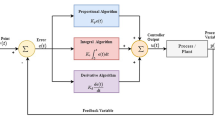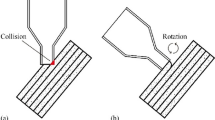Abstract
This article presents the design and real-time implementation of an optimal collaborative approach to obtain the desired trajectory tracking of two Degree of Freedom (DOF) pantograph end effector position. The proposed controller constructively synergizes the Proportional Integral Derivative (PID) and Linear Quadratic Regulator (LQR) by taking their weighted sum. Particle Swarm Optimization (PSO) algorithm is proposed to optimally tune the gains of PID, weighting matrices of LQR, and their ratio of contributions. Initially, the PID and LQR controller parameters are optimally tuned using PSO. In order to enhance the control effort and to provide more optimal performance, the weightages of each controller are optimally tuned and are kept constant. The collaborative position control strategy is tested against the PID and the LQR controllers via hardware in loop trials on a robotic manipulator. Experimental results are provided to validate the accurate trajectory tracking of the proposed controller. Results demonstrate that the optimal combination renders a significant improvement of 10% in steady-state response and about 37% in transient response over the PID and LQR schemes.
Similar content being viewed by others
References
J. Iqbal, R. U. Islam, S. Z. Abbas, A. A. Khan, and S. A. Ajwad, “Automating industrial tasks through mechatronic systems a review of robotics in industrial perspective,” Tehnički vjesnik, vol. 23, no. 3, pp. 917–924, 2016.
R. Samah, M. Kidouche, and A. Rezoug, “Adaptive robust nonsingular terminal sliding mode design controller for quadrotor aerial manipulator,” Telkomnika, vol. 17, no. 3, pp. 1501–1512, 2019.
J. Seo, J. Kim, S. Park, and J. Cho, “A SLIP-based robot leg for decoupled spring-like behavior: Design and evaluation,” International Journal of Control, Automation and Systems, vol. 17, no. 9, pp. 2388–2399, 2019.
J. Iqbal, M. Ullah, S. G. Khan, B. Khelifa, and S. Ćuković, “Nonlinear control systems — A brief overview of historical and recent advances,” Nonlinear Engineering, vol. 6, no. 4, pp. 301–312, 2017.
J. Iqbal, “Modern control laws for an articulated robotic arm: Modeling and simulation,” Engineering, Technology & Applied Science Research, vol. 9, no. 2, pp. 4057–4061, 2019.
Z. S. Awan, K. Ali, J. Iqbal, and A. Mehmood, “Adaptive backstepping based sensor and actuator fault tolerant control of a manipulator,” Journal of Electrical Engineering and Technology, vol. 14, no. 2, pp. 2497–2504, 2019.
W. Alam, S. Ahmad, A. Mehmood, and J. Iqbal, “Robust sliding mode control for flexible joint robotic manipulator via disturbance observer,” Description of Complex Systems: INDECS, vol. 17, no. 1-B, pp. 85–97, 2019.
O. Khan, M. Pervaiz, E. Ahmad, and J. Iqbal, “On the derivation of novel model and sophisticated control of flexible joint manipulator,” Revue Roumaine des Sciences Techniques-Serie Electrotechnique et Energetique, vol. 62, no. 1, pp. 103–108, 2017.
S. khan, S. Bendoukha, W. Naeem, and J. Iqbal, “Experimental validation of an integral sliding mode-based LQG for the pitch control of a UAV-mimicking platform,” Advances in Electrical and Electronics Engineering, vol. 17, no. 3, pp. 275–284, 2019.
N. Ali, W. Alam, A. Ur Rehman, and M. Pervaiz, “State and disturbance observer based control for a class of linear uncertain systems,” Proc. of the International Conf. on Frontiers of Information Technology, pp. 139–143, 2017.
S. A. Ajwad, J. Iqbal, R. U. Islam, A. Alsheikhy, A. Almeshal, and A. Mehmood, “Optimal and robust control of multi DOF robotic manipulator: Design and hardware realization,” Cybernetics and Systems, vol. 49, no. 1, pp. 77–93, 2018.
H. Feng, C. B. Yin, W. W. Weng, W. Ma, J. J. Zhou, W. H. Jia, and Z. L. Zhang, “Robotic excavator trajectory control using an improved GA based PID controller,” Mechanical Systems and Signal Processing, vol. 105, pp. 153–168, 2018.
H. V. H. Ayala and L. dos S. Coelho, “Tuning of PID controller based on a multiobjective genetic algorithm applied to a robotic manipulator,” Expert Systems with Applications, vol. 39, no. 10, pp. 8968–8974, 2012.
L. Sun and J. Gan, “Researching of two-wheeled self-balancing robot base on LQR combined with PID” Proc. of the 2nd International Workshop on Intelligent Systems and Applications, pp. 1–5, 2010.
S. Bagheri, T. Jafarov, L. Freidovich, and N. Sepehri, “Beneficially combining LQR and PID to control longitudinal dynamics of a SmartFly UAV,” Proc. of the 7th Annual Information Technology, Electronics and Mobile Communication Conference, pp. 1–6, 2016.
R. M. Asl, A. Mahdoudi, E. Pourabdollah, and G. Klančar, “Combined PID and LQR controller using optimized fuzzy rules,” Soft Computing, vol. 23, no. 13, pp. 5143–5155, 2019.
G. Ghosh, P. Mandal, and S. C. Mondal, “Modeling and optimization of surface roughness in keyway milling using ANN, genetic algorithm, and particle swarm optimization,” The International Journal of Advanced Manufacturing Technology, vol. 100, no. 5, pp. 1223–1242, 2019.
G. I. Sayed, A. Tharwat, and A. E. Hassanien, “Chaotic dragonfly algorithm: an improved metaheuristic algorithm for feature selection,” Applied Intelligence, vol. 49, no. 1, pp. 188–205, 2019.
D. Fister, I. Fister Jr, I. Fister, and R. Šafarič, “Parameter tuning of PID controller with reactive nature-inspired algorithms,” Robotics and Autonomous Systems, vol. 84, pp. 64–75, 2016.
A. Al-Mahturi and H. Wahid, “Optimal tuning of linear quadratic regulator controller using a particle swarm optimization for two-rotor aerodynamical system,” International Journal of Electronics and Communication Engineering, vol. 11, no. 2, pp. 184–190, 2017.
V. Saisudha, G. Seeja, R. Pillay, G. Manikutty, and R. Bhavani, “Analysis of speed control of DC motor using LQR method,” International Journal of Control Theory and Applications, vol. 9, no. no.15, pp. 7377–7385, 2016.
H. Freire, P. B. M. Oliveira, and E. J. S. Pires, “From single to many-objective PID controller design using particle swarm optimization,” International Journal of Control, Automation and Systems, vol. 15, no. 2, pp. 918–932, 2017.
J. Y. Jhang, C. J. Lin, C. T. Lin, and K. Y. Young, “Navigation control of mobile robots using an interval type-2 fuzzy controller based on dynamic-group particle swarm optimization,” International Journal of Control, Automation and Systems, vol. 16, no. 5, pp. 2446–2457, 2018.
Quanser handout, Rotary Servo Base Unit, accessed on October 31, 2019. Available on: https://www.quanser.com/products/rotary-servo-base-unit/
I. M. Mehedi, U. Ansari, U. M. Al-Saggaf, and A. H. Bajodah, “Controlling a rotary servo cart system using robust generalized dynamic inversion,” International Journal of Robotics and Automation, vol. 35, no. 1, pp. 77–85, 2020.
K. Latha, V. Rajinikanth, and P. M. Surekha, “PSO-based PID controller design for a class of stable and unstable systems,” ISRN Artificial Intelligence, vol. 2013, 2013.
M. Wasim, M. Ullah, and J. Iqbal, “Gain-scheduled proportional integral derivative control of taximodel of unmanned aerial vehicles,” Revue Roumaine des Sciences Techniques-Serie Electrotechnique et Energetique, vol. 64, no. 1, pp. 75–80, 2019.
O. Saleem and M. Rizwan, “Performance optimization of LQR-based PID controller for DC-DC buck converter via iterative-learning-tuning of state-weighting matrix,” International Journal of Numerical Modelling: Electronic Networks, Devices and Fields, vol. 32, no. 3, p. e2572, 2019.
Z. Bingül and O. Karahan, “A Fuzzy Logic Controller tuned with PSO for 2DOF robot trajectory control,” Expert Systems with Applications, vol. 38, no. 1, pp. 1017–1031, 2011.
A. R. Bhatti, Z. Salam, B. Sultana, N. Rasheed, A. B. Awan, U. Sultana, and M. Younas, “Optimized sizing of photovoltaic grid-connected electric vehicle charging system using particle swarm optimization,” International Journal of Energy Research, vol. 43, no. 1, pp. 500–522, 2019.
Author information
Authors and Affiliations
Corresponding author
Additional information
Publisher’s Note Springer Nature remains neutral with regard to jurisdictional claims in published maps and institutional affiliations.
Nihad Ali received his B.S. degree in electronic and an M.S. degree in control engineering from University of Engineering and technology, Peshawar and COMSATS University, Islamabad, Pakistan, in in 2014 and 2017, respectively. He is currently working as research assistant at National University of Science and technology, Islamabad. His research interests include sliding mode control, adaptive control and optimal control.
Yasar Ayaz received his B.Eng. degree in mechatronics engineering and an M.Eng. degree in electrical engineering from the National University of Sciences and Technology (NUST), Pakistan, in 2003 and 2005, respectively. He received his Ph.D. degree specializing in robotics and machine intelligence from Tohoku University, Japan, in 2009. He is currently working as the Chairman/Central Project Director of National Center of Artificial Intelligence (NCAI) at NUST, Pakistan. His research interests include motion planning, navigation and control of humanoids and mobile robots.
Jamshed Iqbal holds his Ph.D. degree in robotics from Italian Institute of Technology (IIT) and three Master degrees in various fields of Engineering from Finland, Sweden and Pakistan. He is currently working as a Lecturer (Assistant Professor) - Robotics in the University of Hull, UK. Moreover, he is looking after the BEng/MEng Programme as Programme Director (Mechatronics and Robotics). With more than 20 years of multi-disciplinary experience in industry & academia, his research interests include robot analysis and controllers design. He has more than 80 reputed journal papers on his credit with an Hindex of 33. He has been a senior member of IEEE USA since 2016.
Rights and permissions
About this article
Cite this article
Ali, N., Ayaz, Y. & Iqbal, J. Collaborative Position Control of Pantograph Robot Using Particle Swarm Optimization. Int. J. Control Autom. Syst. 20, 198–207 (2022). https://doi.org/10.1007/s12555-019-0931-6
Received:
Revised:
Accepted:
Published:
Issue Date:
DOI: https://doi.org/10.1007/s12555-019-0931-6




